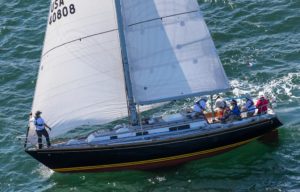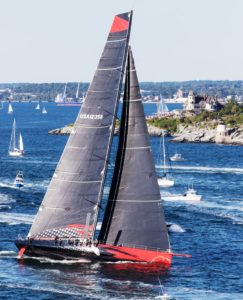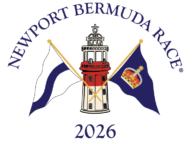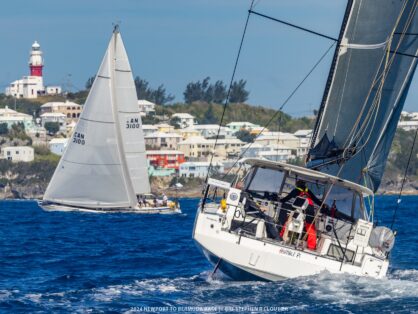Newport, RI. June 18, 2016. 10AM. By JOHN ROUSMANIERE. The first night of the 50th Bermuda Race found the 130 boats in the fleet reaching comfortably in a light westerly wind, most tightly bunched well behind the leader, Comanche. Jim and Kristy Clark’s 100-foot all-out racing sloop covered the first 181 miles in 13 hours. Some 80 miles behind her was the Hubbard family’s Siren, and then the pack. Surrounding them all was concern about upcoming weather.

The New York Yacht Club race committee, which started the race in 16 classes over three hours on Friday afternoon, reported a total of 133 starters in flat water and a 10-knot breeze gradually clocking from South to Southwest. Three boats later withdrew—Challenger, Momentum, and Soulmates—leaving 130 in the race on Saturday morning. Most are directly in Comanche’s wake, but a few have sailed off to the west, undoubtedly with a strategy of making the best of Sunday’s changing weather that has been anticipated all week in forecasts.
The boats and their crews are the story, and also the weather and everybody’s profound concerns about it. Friday night’s and Saturday morning’s weather and sailing have been ideal in every way except high boat speeds and excitement. The wind has been light but not ahead, and so the boats made good speed reaching in smooth water.
Jonathan Green, skipper of the Double-Handed Division boat Jeroboam (defending her 2014 race win), reported as follows at 8PM Friday: “We had a good start off the line and beat down to Point Judith before tacking. We were then lifted to the rhumb line and the lift continued so we are now reaching with the jib barber-haled to the rail and heading straight for Bermuda. Wind may abate this evening but we shall see. All is well on board.”
“We are currently experiencing light westerlies around 7-8 knots,” reported A.J. Evans, sailing in Lenny Sitar’s St. David's Lighthouse Division J-44 Vamp, at 1AM Saturday. “Cool, dry air. Flat or gentle sea state. Nearly full moon (I think that's full on Sunday), with unlimited visibility. We've settled into our offshore routine and are hoping breeze doesn't die as much as forecast. (Evans chairs the Bermuda Race Organizing Committee.)
Inisharon, a 44-footer in the Cruiser Division, had this report around midnight: “Crew is well into the watch schedule and so far beautiful night of idyllic sailing. Wind has come off some, but we are making good progress and trying to get every bit of speed out of the boat. Easy sailing so trying to make sure everyone's getting the sleep they need and charging their batteries in anticipation of a bumpy crossing of the Gulf Stream. 152nm to the entry point of the Gulf Stream, so roughly 30 hours before we get there.”
Forecasts for the Stream
That target--the Gulf Stream entry point--is extremely significant. According to the 6:40 AM Saturday weather forecast from Commanders Weather, once the boats are south of latitude 40 degrees, a front will cause the wind to increase and shift into the north and northeast, and then strengthen on Saturday night and Sunday as the fleet nears the Gulf Stream. This segment of the 635-mile Bermuda Race course always attracts attention because the Stream’s hot water can breed squally weather and steep waves.

This year has seen disagreement among forecasters. Some forecasts earlier in the week called for strong northerly gales and an extremely rough sea as the wind clashes with the Stream’s northerly flow. These gloomy forecasts reportedly influenced 53 crews who had entered the race (including all entries in the Gibbs Hill Lighthouse Division) to either decline to start or, later, to drop out.
According to the new Saturday morning forecast, however, there appears to be a consensus that conditions will be more moderate. There will be wind, but peaking around 35 knots (with higher gusts in squalls). And there will be rough water, but more in line with what experienced Bermuda Race sailors call “typical Gulf Stream conditions”—in other words, uncomfortable but not dangerous to good boats and capable sailors. Time will tell if the conditions will, in fact, be typically bouncy or atypically much worse.
The boats can be followed on Pantaenius Race Tracking, available on the race website. NOTE: A four-hour delay is imposed on reports to prevent competitors taking advantage of other boats' positions.
![]()


































